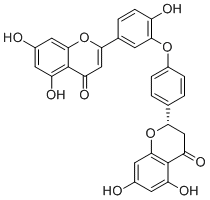2'',3''-DihydroochnaflavoneCAS# 340997-02-6 |

Quality Control & MSDS
Package In Stock
Number of papers citing our products

| Cas No. | 340997-02-6 | SDF | Download SDF |
| PubChem ID | N/A | Appearance | Yellow powder |
| Formula | C30H20O10 | M.Wt | 540.5 |
| Type of Compound | Flavonoids | Storage | Desiccate at -20°C |
| Solubility | Soluble in Chloroform,Dichloromethane,Ethyl Acetate,DMSO,Acetone,etc. | ||
| General tips | For obtaining a higher solubility , please warm the tube at 37 ℃ and shake it in the ultrasonic bath for a while.Stock solution can be stored below -20℃ for several months. We recommend that you prepare and use the solution on the same day. However, if the test schedule requires, the stock solutions can be prepared in advance, and the stock solution must be sealed and stored below -20℃. In general, the stock solution can be kept for several months. Before use, we recommend that you leave the vial at room temperature for at least an hour before opening it. |
||
| About Packaging | 1. The packaging of the product may be reversed during transportation, cause the high purity compounds to adhere to the neck or cap of the vial.Take the vail out of its packaging and shake gently until the compounds fall to the bottom of the vial. 2. For liquid products, please centrifuge at 500xg to gather the liquid to the bottom of the vial. 3. Try to avoid loss or contamination during the experiment. |
||
| Shipping Condition | Packaging according to customer requirements(5mg, 10mg, 20mg and more). Ship via FedEx, DHL, UPS, EMS or other couriers with RT, or blue ice upon request. | ||

2'',3''-Dihydroochnaflavone Dilution Calculator

2'',3''-Dihydroochnaflavone Molarity Calculator
| 1 mg | 5 mg | 10 mg | 20 mg | 25 mg | |
| 1 mM | 1.8501 mL | 9.2507 mL | 18.5014 mL | 37.0028 mL | 46.2535 mL |
| 5 mM | 0.37 mL | 1.8501 mL | 3.7003 mL | 7.4006 mL | 9.2507 mL |
| 10 mM | 0.185 mL | 0.9251 mL | 1.8501 mL | 3.7003 mL | 4.6253 mL |
| 50 mM | 0.037 mL | 0.185 mL | 0.37 mL | 0.7401 mL | 0.9251 mL |
| 100 mM | 0.0185 mL | 0.0925 mL | 0.185 mL | 0.37 mL | 0.4625 mL |
| * Note: If you are in the process of experiment, it's necessary to make the dilution ratios of the samples. The dilution data above is only for reference. Normally, it's can get a better solubility within lower of Concentrations. | |||||

Calcutta University

University of Minnesota

University of Maryland School of Medicine

University of Illinois at Chicago

The Ohio State University

University of Zurich

Harvard University

Colorado State University

Auburn University

Yale University

Worcester Polytechnic Institute

Washington State University

Stanford University

University of Leipzig

Universidade da Beira Interior

The Institute of Cancer Research

Heidelberg University

University of Amsterdam

University of Auckland

TsingHua University

The University of Michigan

Miami University

DRURY University

Jilin University

Fudan University

Wuhan University

Sun Yat-sen University

Universite de Paris

Deemed University

Auckland University

The University of Tokyo

Korea University
- 3',3'''-Binaringenin
Catalog No.:BCN0709
CAS No.:145399-99-1
- 2'',3''-Dihydro-3',3'''-biapigenin
Catalog No.:BCN0708
CAS No.:151455-25-3
- Procyanidin B2 3,3'-di-O-gallate
Catalog No.:BCN0707
CAS No.:79907-44-1
- 6,7,4'-Trihydroxyflavanone
Catalog No.:BCN0706
CAS No.:189689-31-4
- Chrysocauloflavone I
Catalog No.:BCN0705
CAS No.:899789-51-6
- 3',3'''-Biapigenin
Catalog No.:BCN0704
CAS No.:151455-26-4
- Ochnaflavone
Catalog No.:BCN0703
CAS No.:50276-96-5
- Shanciol B
Catalog No.:BCN0702
CAS No.:208106-53-0
- 5,6-Dihydroxy-7,8-dimethoxyflavone
Catalog No.:BCN0701
CAS No.:76844-65-0
- Delicaflavone
Catalog No.:BCN0700
CAS No.:343569-15-3
- Luteolin 5-methyl ether
Catalog No.:BCN0699
CAS No.:58115-29-0
- Violanone
Catalog No.:BCN0698
CAS No.:52250-38-1
- Procyanidin B5
Catalog No.:BCN0711
CAS No.:12798-57-1
- Procyanidin B2 3''-O-gallate
Catalog No.:BCN0712
CAS No.:73086-04-1
- 2"-O-Glucosylrutin
Catalog No.:BCN0713
CAS No.:55696-55-4
- 2,3-Dihydroamentoflavone
Catalog No.:BCN0714
CAS No.:34340-51-7
- Procyanidin B-5 3,3'-di-O-gallate
Catalog No.:BCN0715
CAS No.:106533-60-2
- Quercetin dimer
Catalog No.:BCN0716
CAS No.:167276-19-9
- 3'',4''-Di-O-p-coumaroylquercitrin
Catalog No.:BCN0717
CAS No.:437615-43-5
- Pinobanksin 3-(2-methyl)butyrate
Catalog No.:BCN0718
CAS No.:1221923-43-8
- Derrisisoflavone J
Catalog No.:BCN0719
CAS No.:2172624-67-6
- Epimedonin L
Catalog No.:BCN0720
CAS No.:2215102-38-6
- Derrisisoflavone H
Catalog No.:BCN0721
CAS No.:2172624-65-4
- Derrisisoflavone K
Catalog No.:BCN0722
CAS No.:2172624-68-7
The effect of the biflavonoid 2'',3''-dihydroochnaflavone on Trypanosoma cruzi Y strain.[Pubmed:32860937]
Parasitol Int. 2020 Dec;79:102180.
Trypanosoma cruzi is the causative agent of Chagas disease which affects 8 million people in Latin America. The parasite possesses high capacity to evade host immune system and the available drugs to treat Chagas disease present low efficacy combined to serious side effects to patients. Therefore, the identification of alternative therapeutics is essential. Brazilian flora exhibits an immense diversity of metabolites with great potential to be developed into new drugs. We investigated the action of 2'',3''-dihydroochnaflavone a biflavonoid extracted from Luxemburgia nobilis Eichler ex Engl. (Ochnaceae) against T. cruzi (Y strain). Our experiments showed that this compound is effective against parasite epimastigote forms, presenting IC50 value of (2.5 +/- 0.1) muM after 96 h of treatment. Ultrastructure alterations were also detected in treated epimastigotes especially mitochondrial enlargement at the kinetoplast region. At the concentration of 30 muM, the compound killed (61.6 +/- 3.37)% of the parasite in its amastigote form. In addition, at the same concentration, the compound killed all trypamastigotes growing within murine macrophages after 7-9 days of infection. Nonetheless, the biflavonoid concentrations were harmless to murine enriched population of lymphocytes and peritoneal macrophages. These results indicate that 2'',3''- dihydroochnaflavone presents activity against T. cruzi.
Ether-linked biflavonoids from Quintinia acutifolia.[Pubmed:15104507]
J Nat Prod. 2004 Apr;67(4):693-6.
The New Zealand tree Quintinia acutifolia has yielded four biflavonoids, the new 2,3,2'',3''-tetrahydroochnaflavone (3), and its 7,7''-di-O-methyl derivative (1). The rare 7-O-methyl-2,3,2'',3''-tetrahydroochnaflavone (2) and 2'',3''-dihydroochnaflavone (4), both previously identified only from members of the Ochnaceae, were also isolated. Structures were determined by spectroscopic methods. This is the first report of biflavonoids from the Grossulariaceae.


